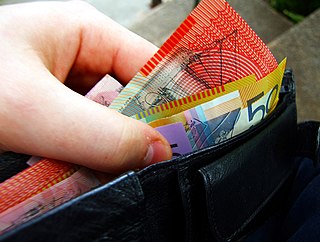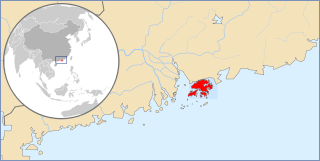Related Research Articles

Polypropylene (PP), also known as polypropene, is a thermoplastic polymer used in a wide variety of applications. It is produced via chain-growth polymerization from the monomer propylene.

A banknote—also called a bill, paper money, or simply a note—is a type of negotiable promissory note, made by a bank or other licensed authority, payable to the bearer on demand. Banknotes were originally issued by commercial banks, which were legally required to redeem the notes for legal tender when presented to the chief cashier of the originating bank. These commercial banknotes only traded at face value in the market served by the issuing bank. Commercial banknotes have primarily been replaced by national banknotes issued by central banks or monetary authorities.

Clydesdale Bank is a trading name used by Clydesdale Bank plc for its retail banking operations in Scotland.

Security printing is the field of the printing industry that deals with the printing of items such as banknotes, cheques, passports, tamper-evident labels, security tapes, product authentication, stock certificates, postage stamps and identity cards. The main goal of security printing is to prevent forgery, tampering, or counterfeiting. More recently many of the techniques used to protect these high-value documents have become more available to commercial printers, whether they are using the more traditional offset and flexographic presses or the newer digital platforms. Businesses are protecting their lesser-value documents such as transcripts, coupons and prescription pads by incorporating some of the features listed below to ensure that they cannot be forged or that alteration of the data cannot occur undetected.
De La Rue plc is a British company headquartered in Basingstoke, England, that produces secure digital and physical solutions to protect goods, trade and identities in 140 countries. Its Authentication division provides Government Revenue Solutions, Brand Protection and ID Security Solutions, such as polycarbonate data pages for passports. Its Currency division designs and produces banknotes, secure polymer substrate and banknote security features. This includes security holograms, security threads and security printed products for central banks and currency issuing authorities. It is listed on the London Stock Exchange. It is the world's largest commercial printer of banknotes.

Polymer banknotes are banknotes made from a synthetic polymer such as biaxially oriented polypropylene (BOPP). Such notes incorporate many security features not available in paper banknotes, including the use of metameric inks. Polymer banknotes last significantly longer than paper notes, causing a decrease in environmental impact and a reduced cost of production and replacement. Modern polymer banknotes were first developed by the Reserve Bank of Australia (RBA), Commonwealth Scientific and Industrial Research Organisation (CSIRO) and The University of Melbourne. They were first issued as currency in Australia during 1988 ; by 1996, the Australian dollar was switched completely to polymer banknotes. Romania was the first country in Europe to issue a plastic note in 1999 and became the third country after Australia and New Zealand to fully convert to polymer by 2003.

The issue of banknotes of the Hong Kong dollar is governed in the Special Administrative Region of Hong Kong by the Hong Kong Monetary Authority (HKMA), the governmental currency board of Hong Kong. Under licence from the HKMA, three commercial banks issue their own banknotes for general circulation in the region. Notes are also issued by the HKMA itself.

The Moroccan dirham is the official monetary currency of Morocco. It is issued by the Bank Al-Maghrib, the central bank of Morocco. One Moroccan dirham is subdivided into 100 santimat.

Hot-melt adhesive (HMA), also known as hot glue, is a form of thermoplastic adhesive that is commonly sold as solid cylindrical sticks of various diameters designed to be applied using a hot glue gun. The gun uses a continuous-duty heating element to melt the plastic glue, which the user pushes through the gun either with a mechanical trigger mechanism on the gun, or with direct finger pressure. The glue squeezed out of the heated nozzle is initially hot enough to burn and even blister skin. The glue is sticky when hot, and solidifies in a few seconds to one minute. Hot-melt adhesives can also be applied by dipping or spraying, and are popular with hobbyists and crafters both for affixing and as an inexpensive alternative to resin casting.
Innovia Films, a division of CCL Industries, is an international manufacturer and supplier of biaxially-oriented polypropylene (BOPP) films for speciality packaging, labelling, tobacco overwrap and industrial products. It was once known as UCB Films.

Plastics extrusion is a high-volume manufacturing process in which raw plastic is melted and formed into a continuous profile. Extrusion produces items such as pipe/tubing, weatherstripping, fencing, deck railings, window frames, plastic films and sheeting, thermoplastic coatings, and wire insulation.
Note Printing Australia (NPA) is a wholly owned subsidiary of the Reserve Bank of Australia (RBA) that produces banknotes and passports. It was corporatised in July 1998 and is located in Craigieburn, Melbourne. NPA has its origins as a subsidiary of the Commonwealth Bank and was established in 1913 to print banknotes for Australia. After printing paper banknotes for 75 years, NPA introduced the first polymer banknote technology in 1988. NPA print banknotes for several other countries as well as Australia due to the high standards of durability and difficulty of counterfeiting.
The notes of the Australian dollar were first issued by the Reserve Bank of Australia on 14 February 1966, when Australia changed to decimal currency and replaced the pound with the dollar. This currency was a lot easier for calculating compared to the previous Australian pound worth 20 shillings or 240 pence.

Plastic film is a thin continuous polymeric material. Thicker plastic material is often called a "sheet". These thin plastic membranes are used to separate areas or volumes, to hold items, to act as barriers, or as printable surfaces.

The Philippine five hundred-peso note (₱500) is a denomination of Philippine currency. Senator Benigno Aquino Jr. and his wife, President Corazon Aquino are currently featured on the front side of the note, while the Puerto Princesa Subterranean River National Park and the blue-naped parrot are featured on the reverse side. BSP will issue the polymer version of this denomination by 2023 and will be the second denomination in this format after the 1000-Piso polymer banknote issued last April 2022.

The Frontier series is the seventh series of banknotes of the Canadian dollar released by the Bank of Canada, first circulated in 2011. The polymer banknotes were designed for increased durability and to incorporate more security features over the preceding 2001 Canadian Journey series. The notes feature images that focus on historic Canadian achievements and innovation. Printed on polymer, the 2011 Frontier series was the first series issued by the Bank of Canada printed on a material other than paper. The 2011 Frontier series was followed by the 2018 series.

The Bank of England £5 note, also known as a fiver, is a sterling banknote. It is the smallest denomination of banknote currently issued by the Bank of England. In September 2016, a new polymer note was introduced, featuring the image of Queen Elizabeth II on the obverse and a portrait of Winston Churchill on the reverse. The old paper note, first issued in 2002 and bearing the image of prison reformer Elizabeth Fry on the reverse, was phased out and ceased to be legal tender after 5 May 2017.

The twenty new shekel note (₪20) is the lowest value banknote of the Israeli new shekel, It was first issued in Series A 1988, with the Series B in 1999, and Series C in 2017.
Extrusion welding is one of the processes used to weld thermoplastics and composites, developed in the 1960s as an evolution of hot gas welding. It can be a manual or automated process.
Covema srl was a historic Italian company specializing in the design of plastic processing machinery, based in Milan, via Fontana 1. Founded in 1953 by the Terragni brothers, it also included the companies Corima spa, GBF spa, GBF iberica, RIAP srl, FIRS spa, Covepla Spain, Italproducts srl, Omam spa, TPA srl, AGRIPAK srl, Floraplant srl, Interfinance SA, Technical Die spa, Covema SAE. The technology that Covema has developed since the 1950s is merged into Agripak srl based in Milano and managed by the sons of Marco Terragni: Fabio Terragni (president), Patrizia Terragni and Massimo Terragni.
References
- Boesveld, Sarah (21 June 2011). "Graphic: Canada's new money is polymer in your pocket". National Post. Retrieved 21 November 2011.
- de Heij, Hans (May 2002), Durable banknotes: an overview (PDF)
- Eu, Peter; Chiew, Ben; Straus, Stane (2006). World Polymer Banknotes: A standard reference (2nd ed.). Eureka Metro. ISBN 9834303823.
- Garoffolo, Bruno; Sientek, Paul (April 2009). "Guardian technology starts with the film" (PDF). Billetaria. Cash and Issue Department, Bank of Spain. 3 (5): 25. Retrieved 9 March 2014.
- Hardwick, Bruee; Ghioghiu, Ana (2004). "Guardian substrate as an optical medium for security devices" (PDF). Note Printing Australia. Archived from the original (PDF) on 24 September 2015. Retrieved 8 March 2014.
- Robertson, Grant (3 December 2011). "Funny money: How counterfeiting led to a major overhaul of Canada's money". The Globe and Mail . Retrieved 8 March 2014.
- Life Cycle Assessment of Canada's Polymer Bank Notes and Cotton-Paper Bank Notes (PDF) (Report). PE Americas, Tryskele. Bank of Canada. 27 May 2011. Retrieved 6 March 2014.
{{cite report}}: CS1 maint: others (link) - "Guardian - Facts and figures". Innovia Security. 20 September 2013. Archived from the original on 13 October 2014. Retrieved 8 March 2014.
- "Guardian substrate issuers" (PDF). Innovia Security. October 2015. Retrieved 7 March 2016.